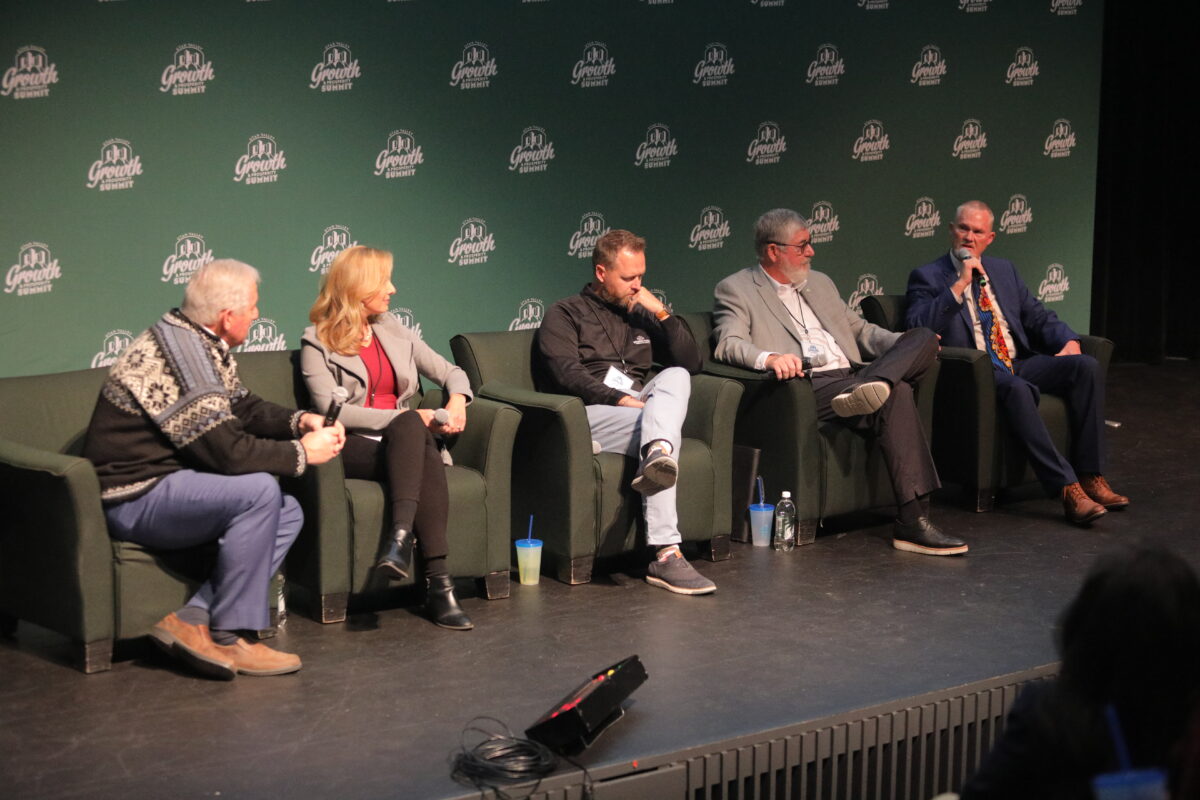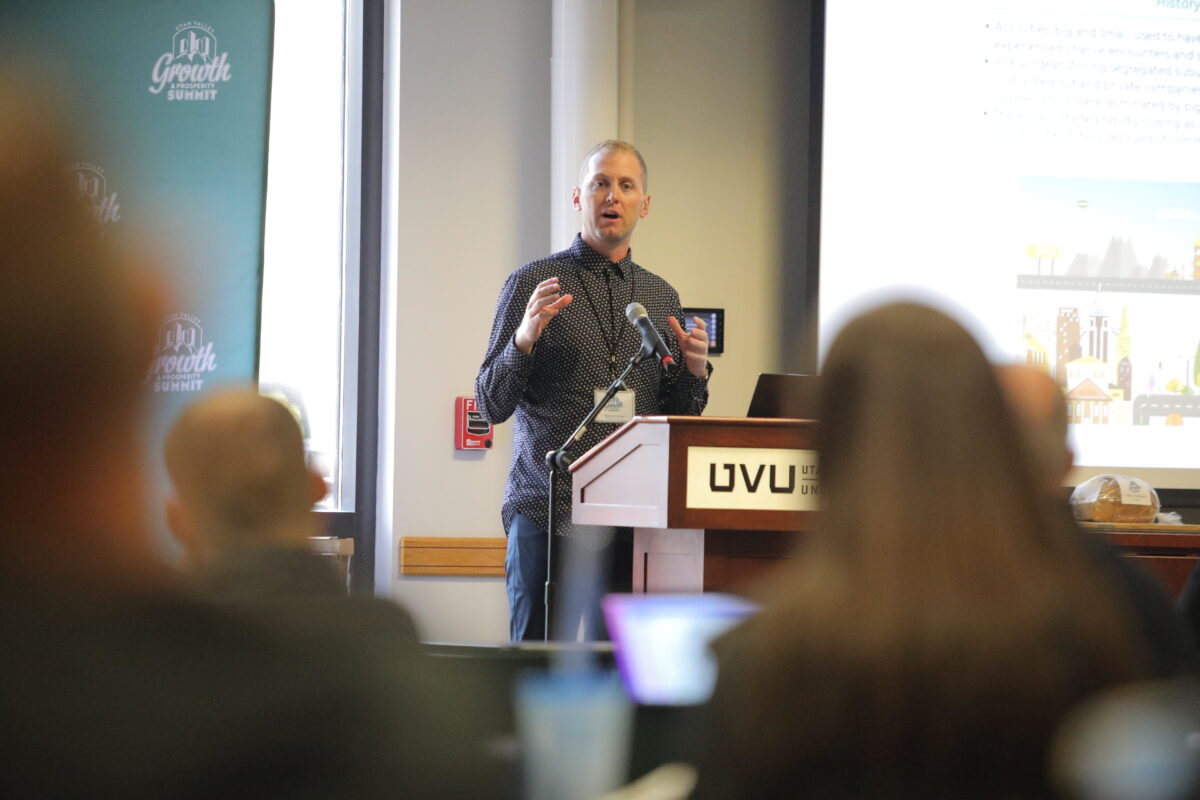Eyes on housing as Utah County leaders meet for second annual growth summit
There’s no one perfect path for the future. Utah County is growing and, on Thursday, dozens of business leaders and politicians from the valley came together to discuss the best ways to move forward and adapt to change.
The second annual Growth & Prosperity Summit, held at Utah Valley University, was organized by the Utah Valley Chamber of Commerce and seeks to hold conversations on countywide issues.
For former Gov. Gary Herbert, executive chair of the chamber of commerce and a longtime county resident, the summit is an opportunity to find the best ways to move forward as a valley and as a state.
“Utah has been a fast-growing area for a long time,” Herbert told the Daily Herald. “The fact that people are moving here means we’ve got something they like and they keep coming. Our challenge is to make sure that we accommodate the growth, which is going to happen.”
The goal of the summit was for leaders to collaborate and discuss ways to manage growth, handle incoming populations and make sure cities are prepared for the future.
“The growth that’s happening is going to happen. Do it in a smart and effective and well-planned way. But do it in a way that protects the quality of life — not only protects the quality of life that people enjoy in our city, but also grows it,” said Mike Mendenhall, mayor of Spanish Fork.
During a panel discussion of Utah County mayors, Mark Johnson, mayor of Lehi, said that meeting the needs of a growing population is vital for every city. By 2030, he told the group, the population of Utah County will double and it will triple by 2065.
While breakout groups focused on everything from Utah Lake to education and clean air, topics like housing and transportation, in particular, weaved themselves through every discussion.
Ari Breuning, president of the growth-focused nonprofit Envision Utah, said the best way to move forward is to build housing units “of all kinds” because adjusting supply is easier than lessening the demand for homes in Utah Valley.
Nate Hutchinson, owner of Flagship Homes, said something similar during his panel discussion. He told the handful of attendees, “the more we build, the faster prices come down.”
Johnson remarked that one of the biggest obstacles to overcoming area growth is people. Specifically, he pointed out the importance of the Constitution and people’s property rights while needing them to accept the needs of community beyond the individual. “I’ve worked hard, but I think I’ve been pretty unsuccessful to help educate individuals and our citizens that everybody’s protected by that document. And people have the right to develop their land and move forward with some of those decisions,” he said.
Beyond individual property, Johnson spoke about Lehi’s vertical growth — handling the Point of the Mountain development and what it will mean for the city. He said the city is currently purchasing property knowing it may take up to a decade for the roads to be built out, purely because the infrastructure will be necessary one day. To handle the increased transit that will come with increased work on the Point of the Mountain project, Lehi has six transit-oriented development projects already underway.
“We’re concerned about sewer, we’re concerned about water. Just like everybody is, (of) course, transportation. We’re concerned about power, because we have our own power system,” he said.
Walking a tightrope in the discussion was Lindon Mayor Carolyn Lundberg. Geographically, Lindon has almost no room to grow, with Pleasant Grove and Orem to the north and south and mountains and water to the east and west. She commented that community voice is integral to any decisions.
For managing growth in the relatively diminutive city, measuring at 2.5 by 7 square miles, Lundberg said the city is working to balance where high-density housing is built, mixing “different housing opportunities within established neighborhoods and communities.”
While Lindon is locked in, spatially, other cities have the opposite problem. Tom Westmoreland, mayor of Eagle Mountain, remarked that the city has a blend of urban and rural areas, but “with it all, we’re over 50 square miles of land, and we are not yet a quarter built out.”
In addition to meeting the housing stock, various city leaders discussed meeting the community’s needs in terms of jobs, encouraging small and large business development, and handling environmental questions, whether they revolve around air, earth or water.
During his keynote address, U.S. Rep. Burgess Owens, R-Utah, spoke about Utah’s legacy of building and innovation, particularly around forming strong communities.
An encouraging sign for Curtis Blair, president of the Utah Valley Chamber of Commerce, was how many members of the wider community showed up outside of policymakers and business owners.
“We have a citizen outreach that said, ‘I want to be a part of the conversation. I want to have a voice.’ And in our society today, having a voice matters. Being a part of the trajectory of how we grow and where we grow has been a really important piece of this summit,” Blair said. Next year, he hopes even more people show up and contribute to the conversation.
- From left, UTA trustee and moderator Jeff Acerson, Lindon Mayor Carolyn Lundberg, Spanish Fork Mayor Mike Mendenhall, Lehi Mayor Mark Johnson and Eagle Mountain Mayor Tom Westmoreland participate in a panel of Utah County mayors during the Growth & Prosperity Summit at Utah Valley University in Orem on Thursday, Oct. 27, 2022.
- Nate Hutchinson, owner of Flagship Homes, speaks during a session on housing during the Growth & Prosperity Summit at Utah Valley University in Orem on Thursday, Oct. 27, 2022.
- U.S. Rep Burgess Owens gives the keynote address during the Growth & Prosperity Summit at Utah Valley University in Orem on Thursday, Oct. 27, 2022.









